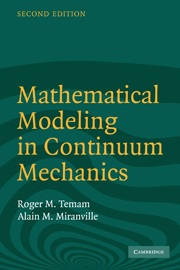Book contents
- Frontmatter
- Contents
- Preface
- A few words about notations
- PART I FUNDAMENTAL CONCEPTS IN CONTINUUM MECHANICS
- PART II PHYSICS OF FLUIDS
- 7 General properties of Newtonian fluids
- 8 Flows of inviscid fluids
- 9 Viscous fluids and thermohydraulics
- 10 Magnetohydrodynamics and inertial confinement of plasmas
- 11 Combustion
- 12 Equations of the atmosphere and of the ocean
- PART III SOLID MECHANICS
- PART IV INTRODUCTION TO WAVE PHENOMENA
- Appendix: The partial differential equations of mechanics
- Hints for the exercises
- References
- Index
10 - Magnetohydrodynamics and inertial confinement of plasmas
Published online by Cambridge University Press: 06 July 2010
- Frontmatter
- Contents
- Preface
- A few words about notations
- PART I FUNDAMENTAL CONCEPTS IN CONTINUUM MECHANICS
- PART II PHYSICS OF FLUIDS
- 7 General properties of Newtonian fluids
- 8 Flows of inviscid fluids
- 9 Viscous fluids and thermohydraulics
- 10 Magnetohydrodynamics and inertial confinement of plasmas
- 11 Combustion
- 12 Equations of the atmosphere and of the ocean
- PART III SOLID MECHANICS
- PART IV INTRODUCTION TO WAVE PHENOMENA
- Appendix: The partial differential equations of mechanics
- Hints for the exercises
- References
- Index
Summary
The purpose of this chapter and of the next one is to present complex problems of fluid mechanics involving other physical phenomena such as electromagnetism (for this chapter) and chemistry (for the next one).
In this chapter, we consider flows of fluids conducting electricity in the presence of electric currents and of electromagnetic fields; the purpose of magnetohydrodynamics (MHD) is to study such flows. The MHD equations consist of the Maxwell equations, which govern the electromagnetic quantities, and of the equations of fluid mechanics in which we include the electro-magnetic forces.
In this chapter, we will limit ourselves to a single fluid flow: in certain circumstances (e.g., very high temperatures, intense electromagnetic fields), the conductive fluid is ionized and becomes a plasma; it then becomes desirable to study the flows of the positive and negative particles separately and, in such a case, one has to deal with a multifluid flow, which is a situation similar to the flow of the mixture of two miscible fluids. That case does not present any particular difficulty; multifluid flows are considered in the next chapter.
The modeling of the electromagnetic phenomena leads to the Maxwell equations, and it can be conducted essentially like the modeling of the mechanical phenomena in Chapters 1 to 5: describing the physical quantities and writing the physical conservation laws, partial differential equations, and boundary conditions. It would be too long, and not particularly instructive from the modeling point of view, to conduct this study here; we will be content with describing the Maxwell equations and will refer the reader to the specialized literature for their physical justification.
- Type
- Chapter
- Information
- Mathematical Modeling in Continuum Mechanics , pp. 158 - 171Publisher: Cambridge University PressPrint publication year: 2005

